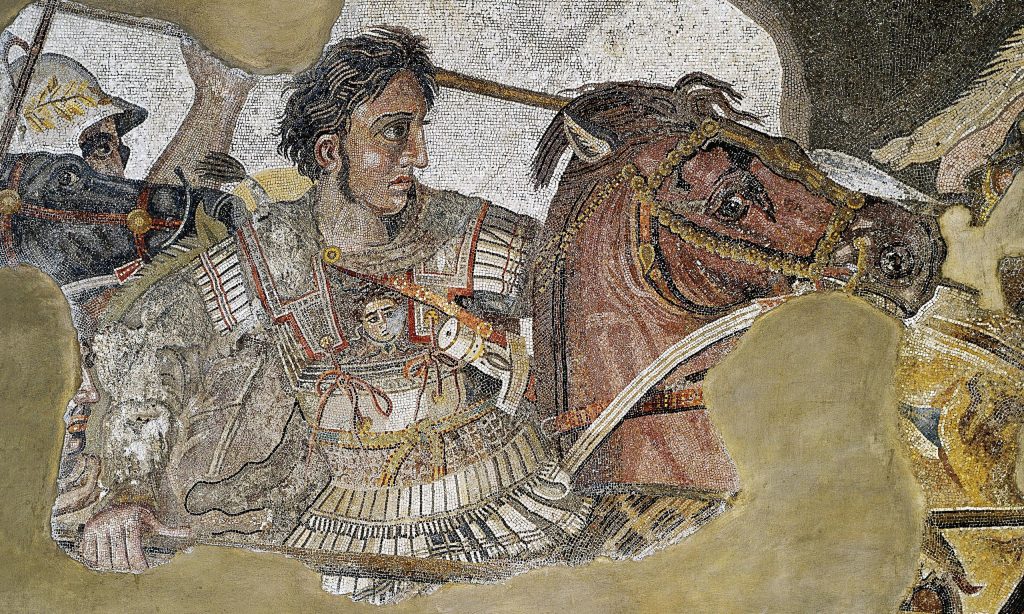Do Attic Greek and Koine Greek represent different eras, different dialects, or something else entirely? More importantly, which one should you learn?
In this article, we will trace the development of Ancient Greek, clear up a few misconceptions, and explain how our approach to language learning equips our students to enjoy Greek literature from any era of antiquity.
The Shift from Attic to Koine
Ancient Greece was home to a number of regional dialects, including Ionic, Aeolic, Attic, and various subdivisions. Attic Greek, spoken by the residents of Athens, was not always prestigious. It did not inaugurate the literary canon. The earliest Greek poets on record composed either in a stylized amalgam of Old Ionic and other dialects (e.g., Homer and Hesiod) or in Aeolic (e.g., Sappho and Alcaeus).
But by the late sixth century BC, political reforms and a formidable navy had made Athens wealthy and powerful. The city-state entered a brief, dazzling period of concentrated brilliance, churning out some of the greatest playwrights, historians, and philosophers the world would ever see—Aeschylus, Sophocles, Euripides, Aristophanes, Herodotus, Thucydides, Xenophon, Socrates, Plato, Aristotle, and more. In a remarkably short span of time, the Attic dialect became the undisputed medium for sophisticated expression in the Greek-speaking world.
Athens’ political supremacy was short-lived, but Attic Greek flourished and spread. It was picked up by the conquering Macedonian kings from the north, then scattered across the ancient world when Alexander the Great subdued vast swathes of territory from North Africa to the threshold of India. Alexander’s empire splintered immediately after his death, but Greek remained the language of trade, administration, and scholarship for centuries under successive rulers—albeit in a less sophisticated, less pristine form.

Although Attic was the gold standard in Greek, instructors across the Mediterranean passed on a simpler version of the language to nonnative speakers, and complexities and irregularities in the original were eroded or discarded altogether through everyday use. The result was a pan-Mediterranean, least-common-denominator Greek. While lacking the stateliness of Attic Greek, this variety was accessible to diverse audiences throughout the Hellenized world. It was koine, i.e., “common.”
Although Koine Greek overtook Attic as the lingua franca, the latter never truly went out of fashion. For centuries, writers who aspired to literariness dipped their pens into the rich inkwell of Attic Greek and affected the Athenian style all over again—even into the Roman era. Attic would forever embody the crowning achievements of Ancient Greece.
Differences Between Attic and Koine
So, Attic Greek vs. Koine Greek—what’s the difference? What was lost in the shift from Attic to Koine? The difference is not as big as you might think. The -mi verb ending became less common. The dual number (specifying two of a thing) vanished, leaving only the singular and plural. Some verbs with irregular conjugations were standardized. Participles (nouns or adjectives formed from a verb, as in “intensive training” or “broken English”) waned in popularity. Similar minor changes occurred throughout the language. Not a whole lot more.
To understand how and why these sorts of changes happened, it is instructive to compare the evolution of English. How many native English speakers today use “whom”—or know how to use it correctly—in speech or writing? Most of us prefer “who,” regardless of context; “whom” might even sound awkward or unnatural to our ears.
READ MORE: How Long Does It Take to Learn a Language?
The subjunctive mood, used to express possibility or desire, is also evaporating from our parlance. A century ago, it might have been common to read a phrase like “If there be any reason…,” but today we would consider such a construction odd and outdated. “Is” communicates the same idea clearly enough.
While these represent different sorts of linguistic changes, they are both motivated by the drive toward simplicity and intelligibility. Nonnative speakers (and often native speakers) cannot be bothered to remember the finer points of grammar and usage, especially when those points are rare or superfluous. Greek underwent a similar trend with the rise of Koine.
Don’t Just Learn “Biblical Greek”
Perhaps you are primarily interested in biblical literature. Why would you bother learning Attic, a more difficult and archaic form of the language, when you will only need Koine to read the New Testament? Can’t you get by without it?
There are several reasons why you should learn Attic Greek and not just the stripped-down Koine of the New Testament.
The first reason is simple: You really do need Attic. Studying Ancient Greek without touching Attic is a bit like majoring in English literature without ever cracking open Shakespeare. This is neither “Bardolatry” nor an expression of Attic supremacy. It is just to say that both Shakespeare and the corpus of Attic literature form the foundation for so much of the literature that comes after them, in English and in Greek, respectively.
Later Greek authors drew reverently from the Athenian heritage. Without Attic, you might be able to translate the New Testament word for word, but you will miss all the ways in which the Apostle Paul and the Septuagint (the Greek translation of the Hebrew Bible, quoted extensively in the New Testament) borrowed from, alluded to, and challenged classical thought. Paul’s sermon at the Areopagus in Athens (Acts 17:22–31), for instance, contains at least two quotations from well-known Greek pagan poets, Epimenides and Aratus, in verses 27 and 28, as well as implicit rebuttals to the philosophies of the Stoics and Epicureans.

It is hard to overstate this point. If your only framework for understanding the Greek of the Bible is, well, Biblical Greek, you will not really understand it at all—because you will basically be memorizing a lexicon instead of learning a language. New Testament vocabulary does not constitute a closed system; its backdrop is the Hellenistic world and the classical texts. To appreciate how, for instance, Paul’s use of koinonia (fellowship, participation, community), dikaiosune (righteousness and justice rolled into one), kerygma (a heraldic proclamation—usually translated “preaching”), or ekklesia (a citizens’ assembly or city council—usually translated “church”) would have struck his readers, you cannot rely on a simple one-for-one formula. Each of these words is richly textured and irreducible. If the only Ancient Greek you learn is the Greek in the New Testament, then you will not have really learned Ancient Greek at all—you will have learned a few scholars’ interpretations of Biblical Greek, which will keep you at the same remove from Jesus’ actual words as if you were relying on an English translation.
The New Testament depends on you, the reader, to picture the original full-bodied concept rather than grope for a weak and watery English substitute. You want to think with the author and the audience. And to do this, you need the words to hit you in the same way. That means digging into Attic to get familiar with the context.
Second, the New Testament is only a fraction of the extant Koine literature. If your only prior experience with Ancient Greek is with the Koine of the Bible, you will have a very limited toolkit for engaging with other texts—even those that were written around the same time. The Greek Fathers will remain hidden behind unfamiliar phraseology and vocabulary, and the pagan Koine writers, such as Marcus Aurelius, Apollonius, and Plutarch, will be even more so. And these are just the Koine writings! When you move back in time, you will find that your Bible reading has prepared you very little to comprehend most other Greek literature. While Koine was designed to be straightforward and functional, Attic Greek has a much broader grammatical, lexical, and stylistic range.

Familiarity with the nuances of Attic will help you navigate a variety of genres and provide the necessary stepping stones to other dialects. Starting from Attic and then venturing into Old Ionic or Aeolic, for instance, is far easier than trying to read Homer, Hesiod, or the Lyric Poets with Biblical Greek as your only reference point.
Third, Attic is only slightly harder than Koine. Yes, learning the former requires you to recognize the dual number, some irregular verb forms, and other peculiarities, but if you are attempting Ancient Greek at all—not an easy task to begin with—you might as well go the whole way and explore the language as it was used during the most prolific period of Greek writing. It only takes a little more effort.
What it really comes down to is the need to read widely. If you only learn enough Greek to read the New Testament, your knowledge will be strictly functional, which is to say, historically and aesthetically impoverished—and you will struggle to make heads or tails of most other writings. But if you take the time to explore Attic literature, you will acquire deep insight into the nuances of the Bible, and from a linguistic perspective, will be as prepared as you possibly could be to come face-to-face with the biblical writers and the flesh-and-blood people whose words they transcribed.
Don’t Just Learn Attic
Finally, perhaps you are approaching this from the opposite end. You might be a prospective classics student thinking you can skip over Koine literature altogether, since Attic is where the good stuff lies. Nothing could be further from the truth!
There are reams and reams of valuable works in Koine that any serious Attic student should read—the biblical writings, of course, as well as influential biographies, histories, and philosophical treatises, to name a few. Do not let the word “Koine” (common) mislead you! Koine Greek is not a basic or ugly language. It can boast some of the most beautiful poetry in the entire corpus of Greek literature.
Further, while we said that studying Greek literature without ever touching Attic would be like studying English without ever touching Shakespeare, something similar (but even stronger) can be said the other way around. More than any other text, the Bible is the cornerstone, not just of later Greek writings, but of all Western civilization. Maybe you should think about reading that?
Because Koine literature does offer such large volumes of interesting content (some accessible at an intermediate level of proficiency), it can provide the one thing necessary for you to truly master Ancient Greek: plenty of comprehensible input. The more you work through enjoyable, understandable material in Ancient Greek, the faster you will acquire the language. So do not neglect Koine. Use it to deepen your love of Ancient Greek and broaden your horizons.
How ALI Teaches Ancient Greek
ALI doesn’t believe in a rigid Attic/Koine distinction. While this dichotomy might be useful for timelines and textbook charts, it breaks down in the classroom. As we have discussed in this article, Koine Greek flowed out of Attic, and Attic literature continued to exert a powerful influence on Greek thought and writing. That is why ALI takes our Beginner and Intermediate-level Greek learners through a general Ancient Greek class rather than teaching a comprehensive “Attic” to some and a truncated “Koine” to others. In our courses, you will become familiar with Greek as it was used in epics, plays, histories, discourses, treatises, biographies, and in the Gospels, epistles, and histories of the New Testament.
You will also make rapid progress. We champion the natural method of language learning, replicating the way each of us acquired our native tongue to master new ones—mainly by hearing and reading relevant messages. To that end, our instructors communicate with the class in Ancient Greek from day one. Rather than toggling between Greek and English, which prevents you from ever getting truly comfortable in the target language, you get into the habit of thinking and responding in Greek through immersion.

ALI’s approach is undergirded by decades of research on the most effective way to learn languages. It is also fun. Through interactive games, videos, online learning platforms, and group reading sessions, you will build a large vocabulary and absorb the structure and feel of the language without having to complete the tedious worksheets that so many language courses rely on.
But the fun aspect is not gimmicky. Ultimately, our students sign up and stick with us because they succeed. It is most rewarding to learn a language when you actually feel like you are learning, not merely memorizing grammar and vocab that you will forget next week.
So whether you want to read Plato or Paul, we will get you there.
The Ancient Language Institute exists to aid students in the language learning journey through online instruction, innovative curriculum, and accessible scholarship about the ancient world and its languages. Are you interested in learning an ancient language?




